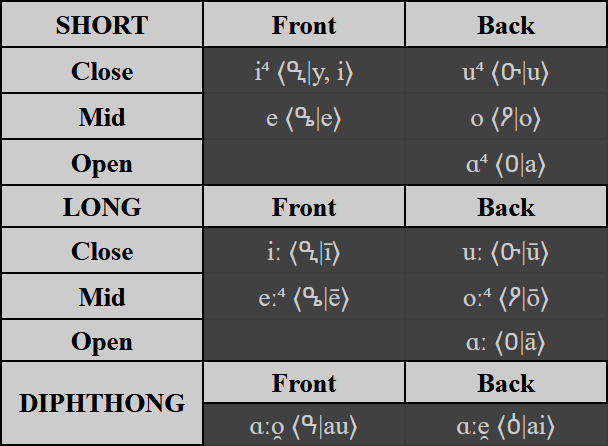Low Planar
Low Planar, also called Samal Vega, is a planar language often associated with certain types of extraplanar entities.
Unlike mortal languages, Low Planar is fixed; it does not experience sound change or divergence.
Low PlanarPronunciation: [ˈsɑːmɐl̪͆ ˈɱb̺͡vegɐ] Ethnicity: Extraplanar entities Language Family:
ሰመለ፡ጴገ
ꖹለ፡ꖨ
(sāmal vega)
Planar?
- Low Planar
Phonology
Consonants

²realised as interdental ([l̪͆] and [θ̪͆])
³realised as a voiceless trill ([r̥]) word-initially, and as a tap ([ɾ]) elsewhere
⁴centralised ([ɪ̞], [ʊ̞], [ɐ], [ɛː], [ɔː]), except /i/, /u/ before hiatus
Vowels

Orthography
Low Planar is written in a unique abuguida, though unlike the Davanic abuguidas, it lacks vowel killer strokes. As such, consonant clusters and final consonants must be inferred. Additionally, the script does not differentiate between short and long vowels As with other abuguidas, it is unicameral. Words are separated by a colon-shaped word separator (፡). Variations on this theme act as other punctuation marks, such as the comma (፣), colon (፥), full stop (።), and question mark (፧). The ፨ symbol is often used at the end of a text or paragraph. There are multiple ways to write quotation marks, but the most common is ᎑᎔. Not all texts are written with punctuation. In addition to this abuguida, there exists a logographic script. The script is highly deficient, only having symbols for so-called tārym vega, while missing symbols for auxiliary words and many morphemes, called menym vega. The symbols of this script are meant to invoke the psychic sensation of the meaning of the morpheme itself, and it is these symbols that magicians use in the practice of magic. The logography of Low Planar served as the basis for Elvish hieroglyphs, with the latter creating a significantly expanded set of symbols to encode the entire Elvish language. Native text: ፦ዐመ፡ፃ፡ጴገ፡ተረ፣ካመ፡ረ፡ሰፐሲየመ፡ፈቴገመ፡ቴረ፡ዮከ፡ሔከተ፥᎑ኆ᎔ꗵ᎑ተ᎔።ዐመ፡ጴገ፡ዬ፡ኀሌሪዮመ፡ና፡ሔሰተ፡ፖጰረ፡ዒጸ፡ዐነፈቴገመ፡ኒፈ፡ተረ።ሒረ፡ፁመ፡ፈጠቱወመ፣ኒሩ፡ኃተ፡ቤነጠመ፡ፈሎሲዮመ፡ሰረከ፡ወረ።᎑ሰፊለመ፡ፂረ፡ጴረ፡ꗵ᎔፨Textual transcription: Ām zau vega tār, kaum rā spāsiam ftegam tera jok hēkat: "kho"KHOT"t". Ām vega yē khleriom nau hetsa povār yts ānaftegam nyf tār. Hyr zūm fthatuam, nīru khaut bēntham flōsiom sārk wāra. "Sfīlām zyra vera KHOT".
Broad phonetic transcription: /ɑːm t̪͡θɑːo̯ vegɐ tɑːr kɑːo̯m rɑː spɑːsi.ɑm ftegɑm terɑ jok ʜeːkɑt χot ɑːm vegɑ jeː χleri.om nɑːo̯ ʜet͡sɑ povɑːr it͡s ɑːnɑftegɑm nif tɑːr ʜir t̪͡θuːm fθɑtu.ɑm niːru χɑːo̯t beːnθɑm floːsi.om sɑːrk ʋɑːrɑ sfiːlɑːm t̪͡θirɑ verɑ χot/
Narrow phonetic transcription: [ˈʔɑːm t̪͡θɑːo̯ ˈɱb̺͡vegɐ tɑːɾ ˈkɑːo̯m r̥ɑː ˈspɑː.si.ɐm ˈfte.gɐm ˈte.ɾɐ jok ˈʜɛː.kɐt ˈχot ˈʔɑːm ˈɱb̺͡ve.gɐ jɛː ˈχl̪͆e.ɾi.om nɑːo̯ ˈʜe.t͡sɐ ˈpo.vɑːɾ ɪ̞t͡s ˈʔɑː.nɐ.fte.gɐm nɪ̞f tɑːɾ ˈʜɪ̞ɾ ˈt̪͡θuːm ˈfθ̪͆ɐ.tu.ɐm ˈniː.ɾʊ̞ ˈχɑːo̯t ˈbɛːn.θ̪͆ɐm ˈfl̪͆ɔː.si.om sɑːɾk ˈʋɑː.ɾɐ ˈsfiːl̪͆ɑːm ˈt̪͡θɪ̞.ɾɐ ˈɱb̺͡ve.ɾɐ ˈχot]


Comments